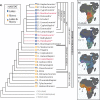Exon-based Phylogenomics and the Relationships of African Cichlid Fishes: Tackling the Challenges of Reconstructing Phylogenies with Repeated Rapid Radiations
- PMID: 35880863
- PMCID: PMC10198650
- DOI: 10.1093/sysbio/syac051
Exon-based Phylogenomics and the Relationships of African Cichlid Fishes: Tackling the Challenges of Reconstructing Phylogenies with Repeated Rapid Radiations
Abstract
African cichlids (subfamily: Pseudocrenilabrinae) are among the most diverse vertebrates, and their propensity for repeated rapid radiation has made them a celebrated model system in evolutionary research. Nonetheless, despite numerous studies, phylogenetic uncertainty persists, and riverine lineages remain comparatively underrepresented in higher-level phylogenetic studies. Heterogeneous gene histories resulting from incomplete lineage sorting (ILS) and hybridization are likely sources of uncertainty, especially during episodes of rapid speciation. We investigate the relationships of Pseudocrenilabrinae and its close relatives while accounting for multiple sources of genetic discordance using species tree and hybrid network analyses with hundreds of single-copy exons. We improve sequence recovery for distant relatives, thereby extending the taxonomic reach of our probes, with a hybrid reference guided/de novo assembly approach. Our analyses provide robust hypotheses for most higher-level relationships and reveal widespread gene heterogeneity, including in riverine taxa. ILS and past hybridization are identified as the sources of genetic discordance in different lineages. Sampling of various Blenniiformes (formerly Ovalentaria) adds strong phylogenomic support for convict blennies (Pholidichthyidae) as sister to Cichlidae and points to other potentially useful protein-coding markers across the order. A reliable phylogeny with representatives from diverse environments will support ongoing taxonomic and comparative evolutionary research in the cichlid model system. [African cichlids; Blenniiformes; Gene tree heterogeneity; Hybrid assembly; Phylogenetic network; Pseudocrenilabrinae; Species tree.].
© The Author(s) 2022. Published by Oxford University Press on behalf of the Society of Systematic Biologists.
Figures




Similar articles
-
African cichlid fishes: morphological data and taxonomic insights from a genus-level survey of supraneurals, pterygiophores, and vertebral counts (Ovalentaria, Blenniiformes, Cichlidae, Pseudocrenilabrinae).Biodivers Data J. 2024 Oct 18;12:e130707. doi: 10.3897/BDJ.12.e130707. eCollection 2024. Biodivers Data J. 2024. PMID: 39464263 Free PMC article.
-
A targeted next-generation sequencing toolkit for exon-based cichlid phylogenomics.Mol Ecol Resour. 2014 Jul;14(4):802-11. doi: 10.1111/1755-0998.12222. Epub 2014 Feb 5. Mol Ecol Resour. 2014. PMID: 24410873
-
Multilocus phylogeny and rapid radiations in Neotropical cichlid fishes (Perciformes: Cichlidae: Cichlinae).Mol Phylogenet Evol. 2010 Jun;55(3):1070-86. doi: 10.1016/j.ympev.2010.02.020. Epub 2010 Feb 21. Mol Phylogenet Evol. 2010. PMID: 20178851
-
Genetic Variation and Hybridization in Evolutionary Radiations of Cichlid Fishes.Annu Rev Anim Biosci. 2021 Feb 16;9:55-79. doi: 10.1146/annurev-animal-061220-023129. Epub 2020 Nov 16. Annu Rev Anim Biosci. 2021. PMID: 33197206 Review.
-
African cichlid fish: a model system in adaptive radiation research.Proc Biol Sci. 2006 Aug 22;273(1597):1987-98. doi: 10.1098/rspb.2006.3539. Proc Biol Sci. 2006. PMID: 16846905 Free PMC article. Review.
Cited by
-
Genome assemblies for Chromidotilapia guntheri (Teleostei: Cichlidae) identify a novel candidate gene for vertebrate sex determination, RIN3.Front Genet. 2024 Aug 16;15:1447628. doi: 10.3389/fgene.2024.1447628. eCollection 2024. Front Genet. 2024. PMID: 39221227 Free PMC article.
-
African cichlid fishes: morphological data and taxonomic insights from a genus-level survey of supraneurals, pterygiophores, and vertebral counts (Ovalentaria, Blenniiformes, Cichlidae, Pseudocrenilabrinae).Biodivers Data J. 2024 Oct 18;12:e130707. doi: 10.3897/BDJ.12.e130707. eCollection 2024. Biodivers Data J. 2024. PMID: 39464263 Free PMC article.
-
Introgression Underlies Phylogenetic Uncertainty But Not Parallel Plumage Evolution in a Recent Songbird Radiation.Syst Biol. 2024 May 27;73(1):12-25. doi: 10.1093/sysbio/syad062. Syst Biol. 2024. PMID: 37801684 Free PMC article.
-
Comparison of seven complete mitochondrial genomes from Lamprologus and Neolamprologus (Chordata, Teleostei, Perciformes) and the phylogenetic implications for Cichlidae.Zookeys. 2023 Nov 15;1184:115-132. doi: 10.3897/zookeys.1184.107091. eCollection 2023. Zookeys. 2023. PMID: 38314327 Free PMC article.
-
Diversity of Sex Chromosomes in Vertebrates: Six Novel Sex Chromosomes in Basal Haplochromines (Teleostei: Cichlidae).Genome Biol Evol. 2024 Jul 3;16(7):evae152. doi: 10.1093/gbe/evae152. Genome Biol Evol. 2024. PMID: 39073759 Free PMC article.
References
-
- Alter S., Munshi-South J., Stiassny M.L.J.. 2017. Genomewide SNP data reveal cryptic phylogeographic structure and microallopatric divergence in a rapids-adapted clade of cichlids from the Congo River. Mol. Ecol. 26:1401–1419. - PubMed
-
- Altschul S.F., Gish W., Miller W., Myers E.W., Lipman D.J.. 1990. Basic local alignment search tool. J. Mol. Biol. 215:403–410. - PubMed
Publication types
MeSH terms
Associated data
LinkOut - more resources
Full Text Sources
Other Literature Sources
Miscellaneous

